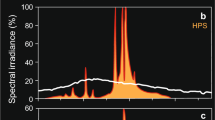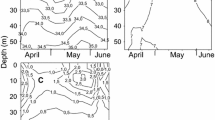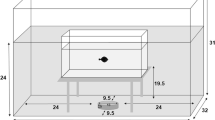Abstract
The behaviour of juvenile herring (Clupea harengus L.) feeding on Artemia sp. nauplii in both light and dark was recorded using an infra-red-sensitive television-recording technique. In the light, two modes of feeding were observed, particle biting and filtering, but in the dark only filtering was observed. Marked differences in swimming behaviour were seen between light and dark. In the light, the fish continued to school while feeding in both modes; in the dark, the school dispersed, the fish swam slower in tight circular paths and fed only by filtering. In the dark, filtering fish swam faster (0.11 m s-1) than non-filtering fish (0.07 m s-1). In the light, no difference in speed was measured between filtering and non-filtering fish (0.34 m s-1). Owing to the lower filtering speeds in the dark, the removal rate of nauplii from the water was much lower than in light, except in the highest prey concentrations. This suggests that if night-time filter-feeding takes place in the sea, it will be of importance only when exploiting dense patches of food.
Similar content being viewed by others
Literature cited
Blaxter, J. H. S.: Spectral sensitivity of the herring Clupea harengus L. J. exp. Biol. 41, 155–162 (1964)
Blaxter, J. H. S. and R. S. Batty: Herring behaviour in the dark: responses to stationary and continuously vibrating obstacles. J. mar. biol. Ass. U.K. 65, 1031–1049 (1985)
Blaxter, J. H. S. and J. R. Hunter: The biology of the clupeoid fishes. Adv. mar. Biol. 20, 1–223 (1982)
Dempsey, C. H.: Chemical stimuli as a factor in feeding and interspecific behaviour of herring larvae. J. mar. biol. Ass. U.K. 58, 797–803 (1978)
Durbin, A. G. and E. G. Durbin: Grazing rates of the Atlantic menhaden Brevoortia tyrannus as a function of particle size and concentration. Mar. Biol. 33, 265–277 (1975)
Gibson, R. N. and I. A. Ezzi: Effect of particle concentration on filter- and particulate-feeding in the herring Clupea harengus. Mar. Biol. 88, 109–116 (1985)
Graham, J. M.: The Bobobat — a 9 bitx9 bit video digitiser for television pictures. Internal Rep. Scott. mar. biol. Ass. 110, 1–15 (1984)
Hettler, W. F.: Influence of temperature and salinity on routine metabolic rate and growth of young Atlantic menhaden. J. Fish. Biol. 8, 55–65 (1976)
Holanov, S. H. and J. C. Tash: Particulate and filter feeding in threadfin shad Dorosoma petenense at different light intensities. J. Fish. Biol. 13, 619–625 (1978)
Hunter, J. R. and H. Dorr: Thresholds for filter feeding in northern anchovy, Engraulis mordax. Rep. Calif. coop. ocean. Fish. Invest. (CalCOFI) 23, 198–204 (1982)
Janssen, J.: Will alewives (Alosa pseudoharengus) feed in the dark? Envir. Biol. Fish. 3, 239–240 (1978)
Author information
Authors and Affiliations
Additional information
Communicated by J. Mauchline, Oban
Rights and permissions
About this article
Cite this article
Batty, R.S., Blaxter, J.H.S. & Libby, D.A. Herring (Clupea harengus) filter-feeding in the dark. Mar. Biol. 91, 371–375 (1986). https://doi.org/10.1007/BF00428631
Accepted:
Issue Date:
DOI: https://doi.org/10.1007/BF00428631




